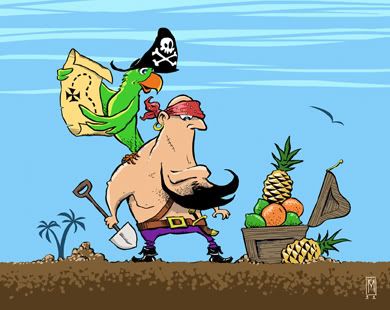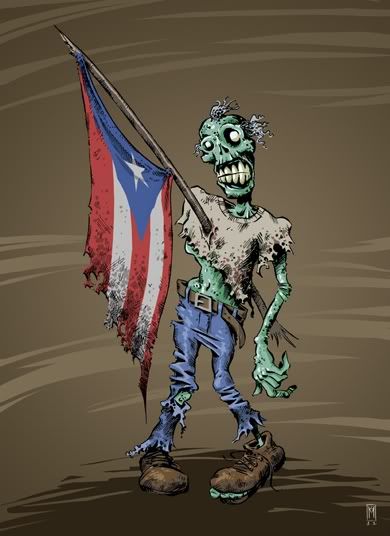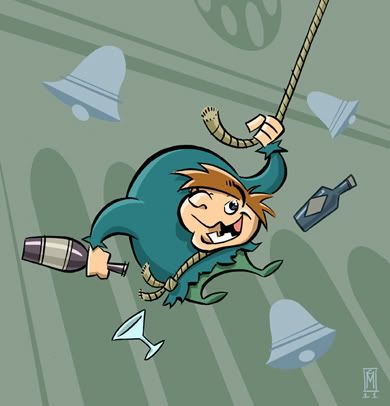Friday, January 21, 2011
Mystery Drink
Pirate's Punch
1 1/2 oz. Dark rum
3/4 oz. Light rum
1/2 oz. 151-proof rum
1 1/2 oz. Fresh pineapple juice
1/2 oz. Fresh orange juice
1/4 oz. Fresh lime juice
1/4 oz. Grenadine
Pour all ingredients into a cocktail shaker with ice. Shake and strain into a tall, ice-filled glass. Garnish with an orange slice and Maraschino cherry.
~ adapted from "Phillip Collier's Mixing New Orleans: Cocktails & Legends" by Jennifer Adams & Michael Terranova, 2007
I'd have thought that by now every drink's history would have been documented. Between the internet and the community of earnest, hardworking booze nerds who spend their days ferreting out the details of where a drink was first made and by whom (or why...or when...), I figured most cocktails had at least a vague backstory attached to them that could be scrounged up with a little effort. Even if a specific creator or date is unknown, many drinks can at least be traced to an appearance in a book or bar somewhere.
Turns out that some drinks may like to keep their pasts hidden.
For quite some time I've had the Pirate's Punch bookmarked in my copy of Mixing New Orleans, where it appears next to a brief piece on Lafitte's Blacksmith Shop, the landmark French Quarter watering hole. When I decided to take it for a test drive, one of the first things I did was to contact the author and see if she had any knowledge of its history. The redoubtable and accommodating Ms. Adams apologized and regretted to inform me she knew nothing of the drink other than it being served at Lafitte's. However, being that the Pirate's Punch is a rum-based concoction, she suggested I contact Martin Cate, the rum guru, proprietor of Smuggler's Cove and all-around swell guy for a possible lead.
His swift reply was, "Never heard of it."
Undeterred, I took my search online and did a cursory look-see. I quickly found out that if you type "Pirate's Punch" into the search engine of your choice, you will receive numerous recipes with that name, but bearing little resemblance to each other. You can even find ones that contain Hawaiian Punch as an ingredient. Vodka too.
Not much in the way of provenance though.
At this stage of the game I could have made the decision to turn this into a project and investigate further. As attractive as the prospect of playing Junior Sherlock was, I didn't want to harangue all my drink geek pals (which I do plenty of already), nor did I want to simply call up Lafitte's and pester some overworked member of the staff. Those people are very busy, and the last thing they need is some dork on the phone asking about their drinks so he can feel somewhat informed as he draws a funny picture.
So I decided that a little mystery is a good thing. If someone out there knows anything about this drink and wants to send it my way, I'm fine with it...but I'm also fine with sipping away and imagining some colorful origin story that may or may not have any connection to reality. Often the made-up stuff sounds better anyway.
Speaking of sipping, I won't abuse you with my usual clumsy tasting notes, but I will point out that the terms "dark rum" and "light rum" can be interpreted very widely, and you could spend the next week and a half experimenting with various ones to see which combos you like. For what it's worth, I found the combination of Ron Atlantico Private Cask and Oronoco made a crisp, citrus-forward version that still showcased the rum flavors well and would be great as a hot-weather drink. And any excuse to use the ol' Lemon Hart 151 is OK by me.
Wednesday, January 12, 2011
The Drinking Dead
Zombie a la Puerto Rico
3/4 oz. Unsweetened pineapple juice
3/4 oz. Papaya nectar
Juice of a sizable lime
3/4 Barspoon powdered sugar
1/3 oz. Apricot brandy
1 oz. 86-proof Puerto Rican white rum
2 oz. 86-proof Puerto Rican gold rum
1 oz. 90-proof Jamaican heavy-bodied rum
Shake all with ice and pour unstrained into Zombie glass, adding cubed ice to nearly fill. Garnish with sprig of mint, small square of pineapple, and 2 cherries skewered on toothpick set so it bridges the rim of the glass. Carefully pour on a shallow float of 151 proof rum. Sprinkle with powdered sugar and stick in a pair of straws.
~ adapted from "The Esquire Drink Book" edited by Frederic A. Birmingham, 1956
Along with its partner-in-crime the Mai Tai, the Zombie is the drink that likely comes to mind when thinking of classic tiki recipes. And like the Mai Tai, it has an entertaining origin story (regardless of whether it's true or not, it's good that any drink's genesis be established in a way that lends itself to enthusiastic retelling. And all the better if that tale of creation is in dispute...it provides a drink with an aura of mystique and gives booze nerds something to research).
And just like the Mai Tai, conclusively determining the origin of the Zombie has been undertaken by Jeff "Beachbum" Berry. You can read the whole tale in his book Sippin' Safari, wherein he not only details his efforts but provides several versions of the drink (his subsequent book, Beachbum Berry Remixed supplies us with even more variations, so if you want to drink something called a Zombie, you've got a bunch to choose from).
However, if you are even a casual tiki drink enthusiast, you're probably already familiar with the lore, so let's get to drinkin'...
The Zombie a la Puerto Rico is one of three Zombie recipes ( I told you there was a bunch of 'em!) that turn up in The Esquire Drink Book, a great old bar guide from the 50's that's one of my favorites to flip through. I've always wanted to make this version, because it follows the basic Zombie blueprint, but also puts an interesting twist or two on it.
The combo of Puerto Rican and Jamaican rums appears in several Zombie versions, and pineapple juice shows up often as well, so we can file those under "usual suspects." However, the apricot brandy and papaya nectar are two ingredients I've never seen in a Zombie before (unless I'd forgotten about them as a result of having too many Zombies). Do they work? I'd say definitely.
One of the things I consider a hallmark of a well-designed and executed tiki drink is complex, layered flavors that remain distinct and in balance. The Zombie a la Puerto Rico succeeds there. You get solid rum flavor as a foundation, but it doesn't come off hot or bludgeon your tongue with sense memories of college drinks that were 90% cheap rum and 10% something else.* Rather, the rums emerge as subtle and elemental, simultaneously powerful and delicate. The mellowness of the brandy and the almost-not-there character of the papaya pulls the whole thing in a drier direction, and the hefty, tart squirt of lime jousts perfectly with the pineapple, leveling everything off with the requisite tropical vibe (although if you like your drinks a little less bitey, I'd suggest dialing the lime juice back slightly).
But like many drinks that get scrounged up from books with brown pages, it's tough to get ahold of ALL the ingredients used at the time the drink was created. I didn't have any Puerto Rican rum that was exactly 86 proof, so I settled for some similar 80-proof Virgin Island products. I also didn't have any robust Jamaican that came in at 90 proof, so I used a fifty-fifty blend of Smith & Cross and Appleton Reserve that did the job just fine as far as I'm concerned.** I also tend to prefer using simple syrup over granular sugar in most drinks, so I just subbed a small splash of Demerara. Fortunately, the gauge on my vat of Lemon Hart 151 still reads "full", and my stash of Marie Brizard Apry saved the day brandy-wise.***
Oh, and I used a tiki mug instead of a Zombie glass. Because I love those goddamned things.
*These were a beloved staple of my college years. A post on this is forthcoming.
**I really want to try working Coruba into this recipe somehow, but until Pennsylvania lowers the force field it has erected to keep it from entering the state, this experiment will have to wait.
***In a nifty bit of timing, Camper from Alcademics kindly pointed out the Washington Post site just posted a piece on apricot brandy. You should take that as some kind of sign.
Labels:
books/magazines,
fellow booze nerds,
rum,
tiki,
vintage,
zombies
Tuesday, January 4, 2011
Sanctuary!
Sanctuary
2 oz. Dubonnet Rouge
1 oz. Amer Picon
1 oz. Triple Sec (I used Cointreau)
Combine all ingredients with cracked ice in a cocktail shaker and shake well. Strain into chilled cocktail glass and garnish with lemon twist.
~ from "The New York Bartender's Guide", edited by Sally Ann Berk
The New York Bartender's Guide, like many items in my collection of boozeware, was a flea market find. I've mentioned before that many of these come courtesy of my father, who regularly travels the local circuit of flea markets, swap meets and the like, never failing to procure all manner of second-hand cocktail ephemera with a price tag of five dollars or less.
Despite its impeccable provenance, this volume is not one I consult often. (Although it has proven it's merit solely by laying to rest a nagging question concerning the recipe of a drink that was a favorite of my wife's grandmother.) However, as I was paging through it in search of a different recipe, I randomly laid eyes on this little number called the Sanctuary. It caught my attention for two reasons:
1) Absence of a base spirit
2) The realization that even though it has only 3 ingredients, this drink could easily go so terribly, terribly wrong.
The lack of a base spirit wasn't that troubling...it made me more curious than apprehensive, so full steam ahead. My main concern was getting the ingredients right. First off, if the Dubonnet was too old, we'd have a problem. Second, if the Amer was lousy, we'd have a problem. And third, if the recipe calls for triple sec, we have a problem.
Now before anyone accuses me of unreasonable anti-triple sec bias, I just need to say that triple sec is perfectly serviceable in a number of drinks. It's just that in my experience there are a variety of other orange liqueurs that can be used in its place that will yield tastier results. Fortunately, I had a handful of them available in Ye Olde Basement Booze Shelves, so I opted for Cointreau this time around.
It also turned out my bottle of Dubonnet was still OK, so I was two-thirds the way home.
That left the Amer. Again I was lucky, because I had a fresh stash of homemade stuff that my fellow cocktail geek SeanMike of the Scofflaw's Den was kind enough to place in my quivering mitts a few weeks ago. It's great, and as I mentioned earlier, I much prefer it to the commercially-made stuff I've tried.
So I broke out the shaker and gave it a go. It's startlingly good, with an overall "vintagey" character that somehow manages both depth and lightness. Also, it's a darn pretty brownish/crimson color that makes you want to dust off your thrift-store coupes* and let the light hit it.
So my advice concerning flea-market cocktail guides is this: If you run across something that looks like it may only have limited potential, consider picking it up anyway. I once heard someone say that even if you only get one good recipe out of a cookbook, the book was worth having. Even if I never find another decent recipe in The New York Bartender's Guide again, I'm still glad I gave it sanctuary on my shelf.
*Everyone buys their fancy glassware in thrift stores, right?
Labels:
fellow booze nerds,
flea market finds,
hunchbacks
Subscribe to:
Comments (Atom)




